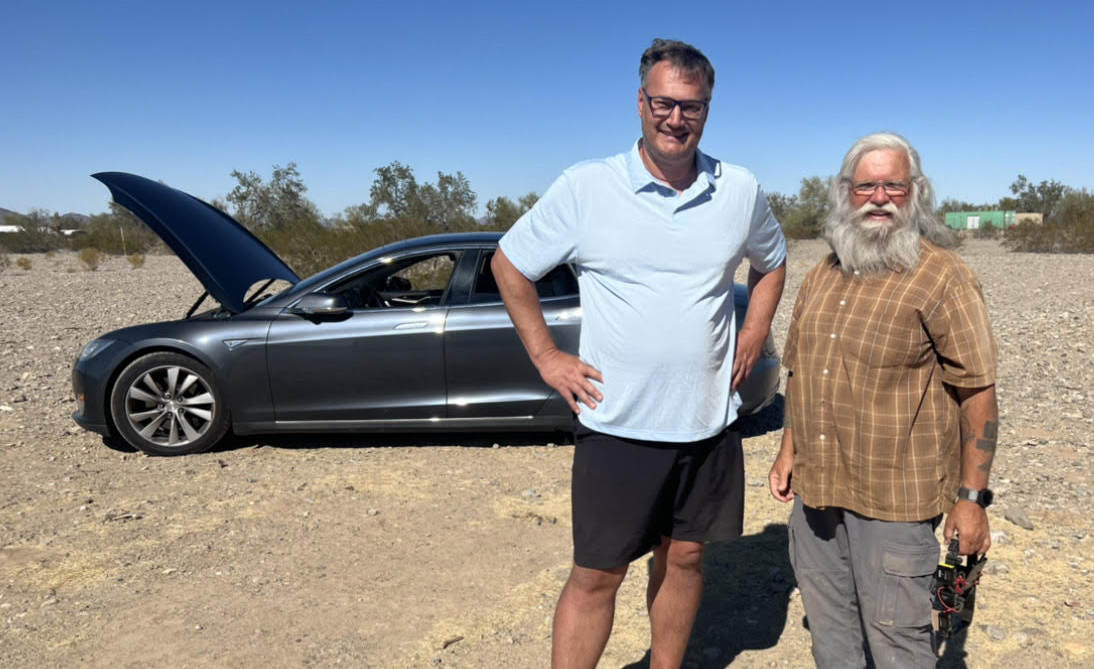
FOR THE LAST TWO YEARS I have been living out of an electric vehicle. EVs can be great vehicles for nomads, but they are certainly not for everyone. They have some great advantages, which are especially beneficial to my lifestyle. But there are also some fundamental downsides that are important to know about. There is an increasing number of EVs on the market, but overall the market for used EVs is rather small. At this time there are also very few electric vans available. Most of my experience is from driving a Tesla Model S for 8 years and converting it to be my home a little over 2 years ago.
EVs are not all that different. They are built very much the same as regular cars. Most of the structure and mechanical parts are the same. The main difference is that they have no engine, no exhaust and no fuel tank. Instead, they have a large battery along the bottom, an electric motor, and some electronics. Contrary to common belief, the electrical system in EVs is actually the same standard 12 Volt system. Almost everything except the main drive motor is a normal 12 Volt system. Lights, windows, fans, radio, wipers,… all is 12 Volt based. In other words, you have access to a 12 Volt outlet just like in your regular vehicle. The main battery in an EV, which is a high voltage battery, is completely separate and sealed safely. There is no easy or accidental access to it so there is no risk of getting electrocuted.
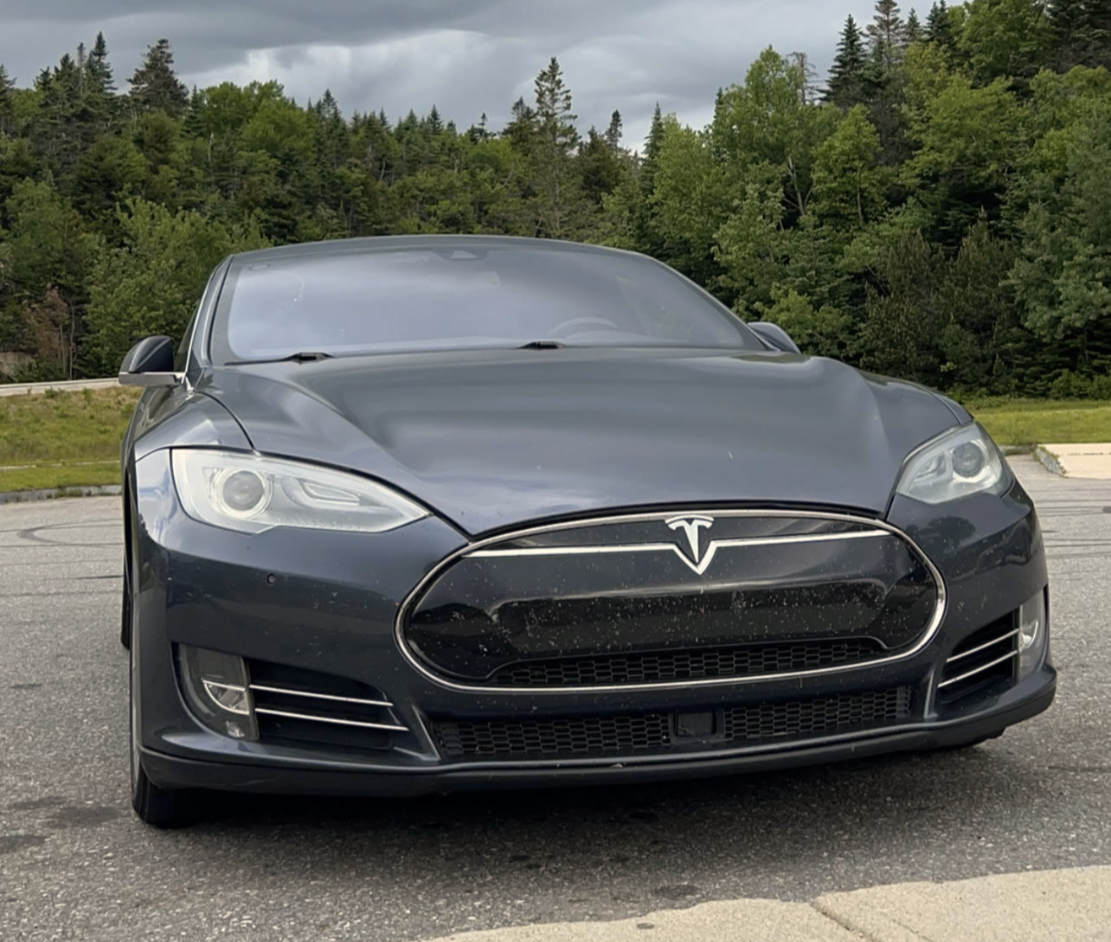
EV Pros and Cons
Let’s talk about some advantages and disadvantages that an EV has over a gasoline vehicle from a nomad’s point of view. Since the most complex part, the engine, isn’t there, engine specific maintenance is not needed. No oil changes, no timing belts, no transmission or clutch, no spark plugs, no air or fuel filter, no fuel pump. Overall the maintenance on an EV is far less which saves you money and there are less things that can fail.
One challenge that nomads have is getting electrical power. The most common method is either using the 12 Volt outlet, or solar panels and large batteries. Both of these options are rather limited. A 12 Volt outlet only works while the engine is running and only allows relatively small loads. The number of solar panels you can fit on a vehicle is not enough to power anything significant like a heater, AC, or typical appliances.
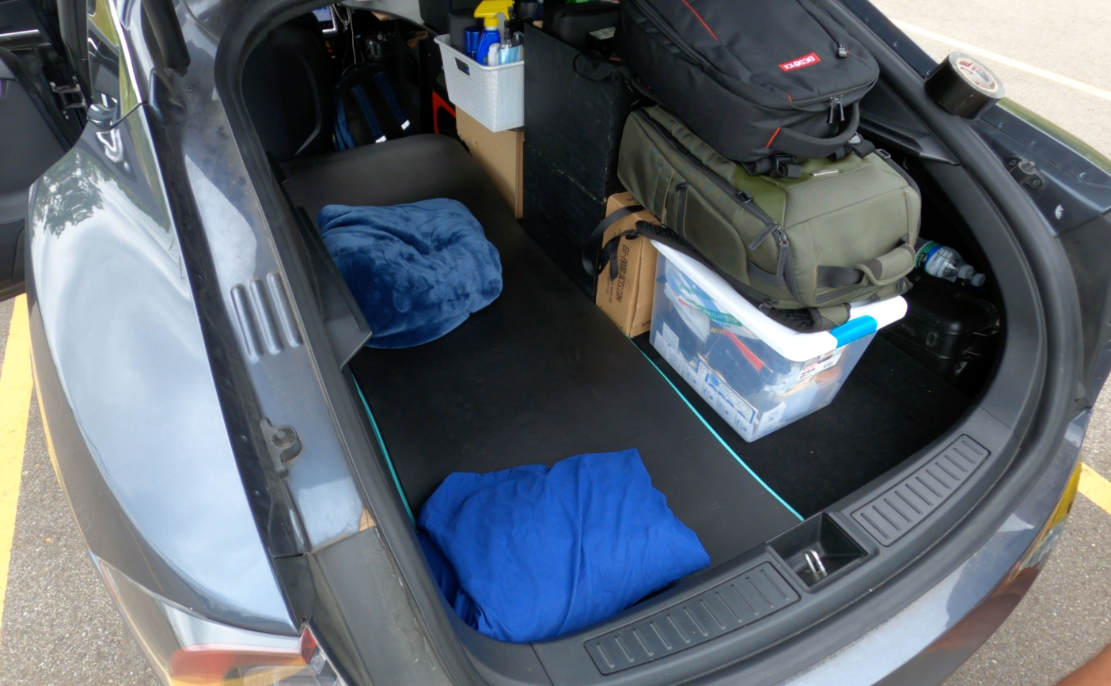
On the other hand, EVs have a giant battery that can store a huge amount of energy which is plenty to run air conditioning, heating and many other devices. Just to give you an idea, 2 golf car batteries hold about 1.2 kWh of energy. A typical EV holds between 60 and 120 kWh.
One of my favorite features living out of an EV is I can keep the climate control running all night and day. Because the main battery is so large it only uses about 5 to 10% to keep the heater or air-conditioning running overnight. The car creates very little noise when doing so because there is no engine that needs to idle. I can easily stealth park in a city keeping the climate control running without anybody noticing. Installing an inverter in your EV allows you to have regular 120 V outlets and run even high power appliances without a problem. Some EVs even have that already built in. I have a 1500 Watt inverter that can run almost anything you would normally plug into a regular outlet.
One of the most common questions I get from people who have never owned an EV is where do you find charging stations? I got my first EV in 2014 when the number of charging stations was still very limited. Even back then it worked just fine even for road trips. Today finding a charging station is no problem anymore. Today the number of charging stations has surpassed gas stations. Having said that, I mostly spend time in cities or developed areas where charging stations are very common. If you are boondocking and prefer to stay away from cities, your options will be limited. Some of the best places to stay in nature are far from charging stations, especially BLM land.
Charging an EV
There are three ways to charge an electric vehicle. The first is called ‘level 1’ charging which means you just plug in the car into a regular 120 V outlet that you find in any house. Unfortunately charging it that way would take several days. The next option is ‘level 2’ charging. Those are dedicated charging stations you see for example in parking lots or structures. They will charge your car overnight. The third option is called level 3 charging which is high power DC. Those chargers are for very fast recharging while you’re taking road trips.
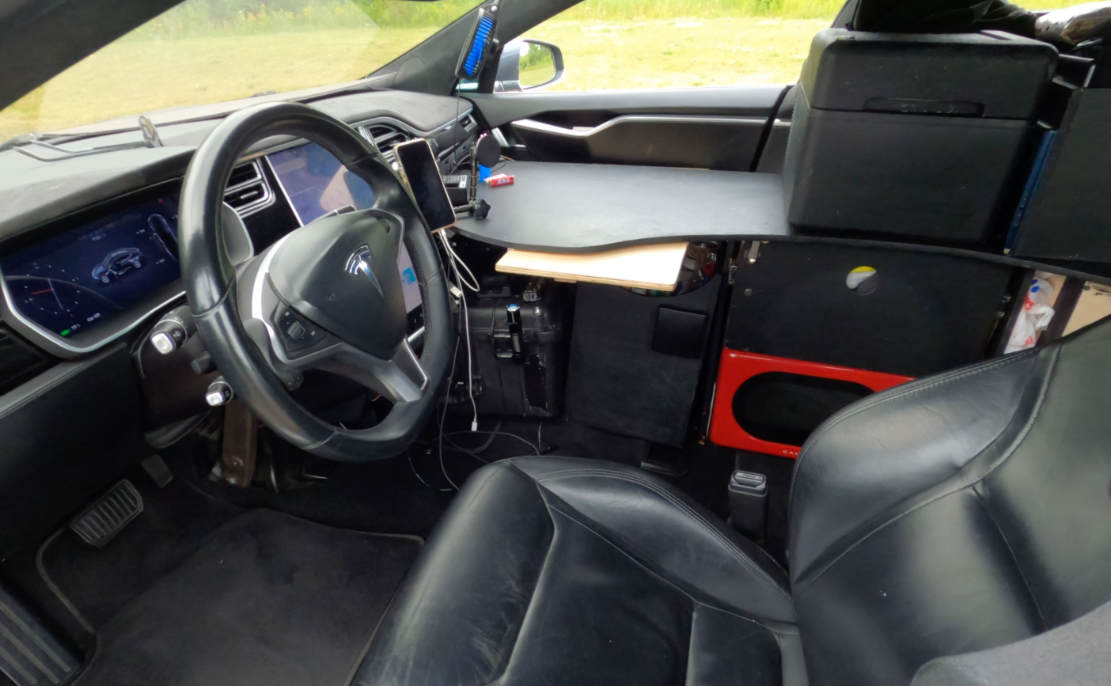
Because I still work full time and spend a lot of time in cities I often find L2 stations and just plug in while I work or go to the gym or shopping or do other things. The cost is similar to what you would pay at a house/apartment for electricity. But often I find free stations that are run by cities or local businesses.
What does charging cost?
How does the cost compare? The cost to run my climate control overnight is approx 70-90 cents when using an average priced charging station. In extreme winter or extreme heat it might be a little more. When I kept the engine of my Honda Odyssey idling to have AC or heating it used approx 3-4 gallons per night. That’s currently $12-15. Driving an EV costs about 6 cents per mile. In my Odyssey it was 20 cents per mile ($4 for a gallon of gasoline). Add to that the cost for oil changes and other regular maintenance the gas or diesel engine needs.
I personally drive a 2015 Tesla Model S. It comes with free charging for the life of the vehicle, so for the most part I drive for free. It has an amazing amount of space inside due to the clever design of the battery in the bottom. Lots of great features like camper mode and internet connection.
Downside is the very low ground clearance. Even bumpy dirt roads are a challenge. If you like to go off main roads, this is not your vehicle.
Since I drive about 50k miles a year, the higher cost upfront for the vehicles is more than offset by the savings on fuel, propane, solar system, and maintenance. All savings combined are about $8-9k every year compared to a gas vehicle. And I’m so much more comfortable because of climate control keeping it perfect regardless of what the weather or outside temperature is.
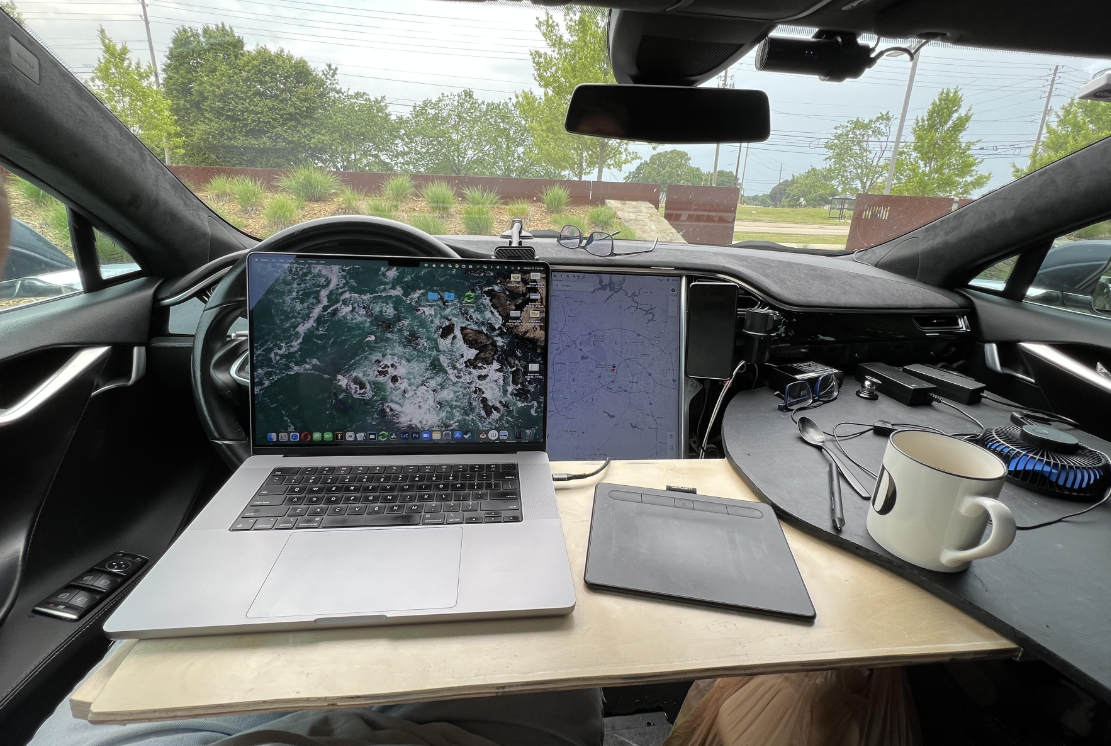
There are currently only compact cars, sedans and small SUVs available as EVs. There are no affordable electric vans at the moment. Almost all car manufacturers are working very hard to convert their fleet to electric, hoping to be able to keep up with the behemoth Tesla who is crushing the EV market right now, but it will be a while before affordable and more nomad friends EVs are available.
When is an EV a good choice for a nomad?
If you are mostly boondocking and prefer to stay away from the city, an EV is probably not your best choice. If you run the main battery down, there is no easy way to have a friend help you out with a canister of gas. Solar panels on an EV are not a viable option. Even if you covered the entire car with solar panels, the amount of energy you could harvest would not be enough to drive much. A 300 Watt solar would provide you with maybe 2-3 miles of range per day in ideal sunny conditions. But only if you refrain from using climate control. Solar on an EV only sounds like a good idea until you do the numbers.
If you are spending most of your time in areas that have charging stations, an EV could be a great option. If you drive long distances regularly, an EV will save you a lot of money compared to gas vehicles. If you stay in an area with extreme weather (hot or cold), an EV will provide you with a comfortable environment.

Howdy ! Nicely written article, excellent & detailed Info. in regard to Tesla Model S EV; by what I have gathered this vehicle will excel in a city environment due its stealthy abilities. LOVE Teslas to start with more now so… Thanks David for you meticulous / informative material.
Thanks so much. It really works great for me and I chose this vehicle specifically for my needs. I’m way more a city dweller and boondocker. I need to drive a lot in cities and draw no attention to my vehicle. I need to stealth park and I need to fir in parking garages. I also drive 50-60k miles a year so I really wanted a vehicle that is mostly a good driving vehicle with decent space to live out of. I do realize many nomads have other needs and priorities.
Very interesting. Have you made interior modifications to your home?
Yes I have modified it quite a bit. Bob made a video touring my car. I hope it will be out soon.
This is why I like hybrids. The best of both worlds. Yes engine turns on for a bit but my Prius C is still very stealth. 5’6” so I am able to sleep comfortably in back. My head towards the hatchback. July 2021 I traveled for a month cross country (Colorado, Utah, Wyoming, Idaho, Oregon, CA and back to NY). I used Planet Fitness (Black Card) for showers. I am buying a Prius V. This will be like a penthouse compared to the C. Gas mileage for my entire trip was 48 miles per gallon. 12,000+ miles.
I agree a good hybrid like the Prius is a good compromise. It does combine the best of both worlds, but it also combines the downsides of both. You have the engine maintenance and the battery size isn’t large enough to run the AC or heater for a reasonable mount of time, then the gas engine kicks in again. The Sienna hybrid has a 1500 Watt inverter built in, so that’s a great feature. Everything is a give and take.
Although a good article overall, I honestly can’t believe you overlooked the Ford Lightening and the Rivian, Pick Up Trucks!
The Lightening has a 300 mile range, or, a substantial towing capacity, as well as rapid charging options and, the ability to power a house for a number of days.
Combined with either a light Pop Up slide in or a lighter trailer, your comfort options (bed, toilet, shower, kitchen) are head and shoulders above car camping.
Airstream recently showed a concept version of a trailer with 900Watts of rooftop solar as well as its own Tesla style, lithium ion battery, AND, electric motor assisted axles, both for maintaining range whilst running down the road as well as manuevering into and out of a campsite.
If you aren’t in a rush to get across country and/or are indeed boondocking on BLM in the S.W., this is potentially a perfect combo, albeit with a hefty initial price tag!
I would bet that as aftermarket lithium ion batteries and electric drive motors become more common place, or even salvaged/used, one could retrofit almost any trailer, within reason (we’re not talking 30 & 40 foot triple axle 5th wheels here) to have similar capabilities.
Yes, Geoff is right! The Ford F-150 Lightening, has the same undercarriage space as a gas guzzler, so off road no problem! YouTube has videos showing and discussing them now, so check them out.
And, trucks have more room to carry solar batteries, and you can pull something behind.
Thanks, though!
Geoff Liked your reply. I’ve been following the movement, planning to retire hoping that an electric option would come along. -also Geoff
You mean the Ford Lightning (“Lightning” as in electrical storm; not “lightening” as in making not as heavy). : )
And EVs are heavier than their internal combustion versions, so maybe they should’ve named it the Heavy-ing. 😀
Al, is the increased Wt due to the large battery they posses ?
Yes.
Al, do you have an estimate on the Tesla’s battery dimensions on Length, width, highth ? Does it occupy the Whole car’s bottom, or is it considerably smaller than that ? thanks for the info.
It’s approximately the dimensions of the entire floor, and about 8-10 inches thick.
Al, thanks for the info. regarding the Tesla’s battery dimensions…WOW, that’s humongous !! ?
Al, EVs are not heavier than gas cars. Here are a few examples of comparable cars.
The Tesla Model S is almost the exact same size as a BMW 7. The BMW is about 2oo lbs heavier.
VW Tiguan and iD4 are about the same weight.
Tesla Model 3 performance and BMW M3 are the same weight.
I’m comparing vehicles that were designed from the start as EVs only.
EVs that are based on gasoline vehicles and the chassis is just repurposed tend to be heaver. If you design an EV from the scratch as an EV it is not heaver nor does it offer less interior space. So far there are only a very small number of EVs that were actually designed as an EV. The vast majority are based on a combustion platform. (Kia Niro, Golf, …)
You are right, there are some electric trucks available now. The cost is rather high and thus the aspect of saving money, which is the reason for many who live out of their vehicle, isn’t there. Once they are available second had for a reasonable price, they might become more interesting. My personal issue with pick up trucks is they are actually not using the space well. The bed is very high and to get a livable space you have to go very high. Shells for pick up trucks are large and scream camping which isn’t working for me trying to be stealth in a city. I also ned to use parking garages in cities often. Getting in and out is a climbing act and you can’t get from the cabin to the back. Using a pickup as a towing vehicle for a camping trailer is perfect, though.
Thank you David for a very informative article- and thank you to some of the commenters – Not every one person knows everything- When we pull together as a community we are a strong force/ support and information resource for one another ??
Great article!
I agree there are different aspects. I drive all across the country and often in regions where EVs are still rare. I get a lot of questions and I notice there are a lot of misconceptions. The funny thing is, even very few people own an EV, everyone has a strong opinion about them or are even experts based on reading articles LOL
One great example is the most common and always the first question I get from people is: ‘How long does it take to charge’. It is just based on the assumption that you have to wait for your car to charge. I always reply by saying, it is like a phone. You don’t plug it in and then sit in front of it and wait for it to charge to 100%. You plug it in and unplug it whenever you need it. Same in a car. I plug it in where there is a charge at the store or parking lot I park anyways. I go shopping or do my work and when I’m done, I drive off. In every day use I never wait for my car to charge. Not even a minute. It charges while I do something else (gym, shopping, work, movies, sleep, eat out).
Long story short, I wanted to give my personal experience of driving an EV for 8 years and driving almost 400k miles electric. There are way too many I-have-done-my-research experts who never owned one. I hope it will help others make a good decision for themselves. I have no agenda. Everyone needs to find what works for them.
Volkswagen will start selling their 100 percent electric ID Buzz minibus into the US market in the fall of 2023.
Boondocking charging is relative. You are correct that a 300 watt panel will not do much or nothing.
How much solar can you carry inside the car or in a trailer?
I am a physicist and have 2 Kurbwatts. Sunpower has flexible panels, and Bob has some videos showing wind that might work with windmills.
Have you determined what the max solar is and what it can do?
Is it possible to carry enough solar/wind to power living without driving while boondocking?
The batteries can power everything from cooking to climate control to even condensing water from the air until they are dead.
Just wondering.
A Tesla truck if ever released could make a great articulated RV.
Hey Peter,
It is certainly possible to use large amount of solar panels and get a reasonable amount of power. But it takes up a lot of space in your rig and if you set it up, you have to secure it safely for the possibility of strong winds. The larger your array, the harder it is to secure from wind. In perfect sunny conditions in the summer in the south you can get aprox the equivalent of 4-5 hours of power at nominal. If you have 2kW of solar you would get 8-10 kWh a day. That’s 20-30 miles of range. Sounds great until you realize you have 360 lbs of solar panels. Now add a structure to set it up and secure it. All panels tightly together are 65 x 40 x 15. That’s a huge amount of space. That’s why I said, you can probably reasonably fit 300 Watt of solar on a sedan or mini van. Once you go larger it becomes quite a hassle. And let’s not forget, the ideal conditions are rarely the case. There are many days with clouds and rain or you are just not in the south with that much sun. Of course if you don’t need climate control and use power conservatively, you can easily get by with just 200 Watt of solar. That’s what I had on my previous vehicle (Honda Odyssey) and it was plenty to even run a microwave.
Thank you for a very informative read.